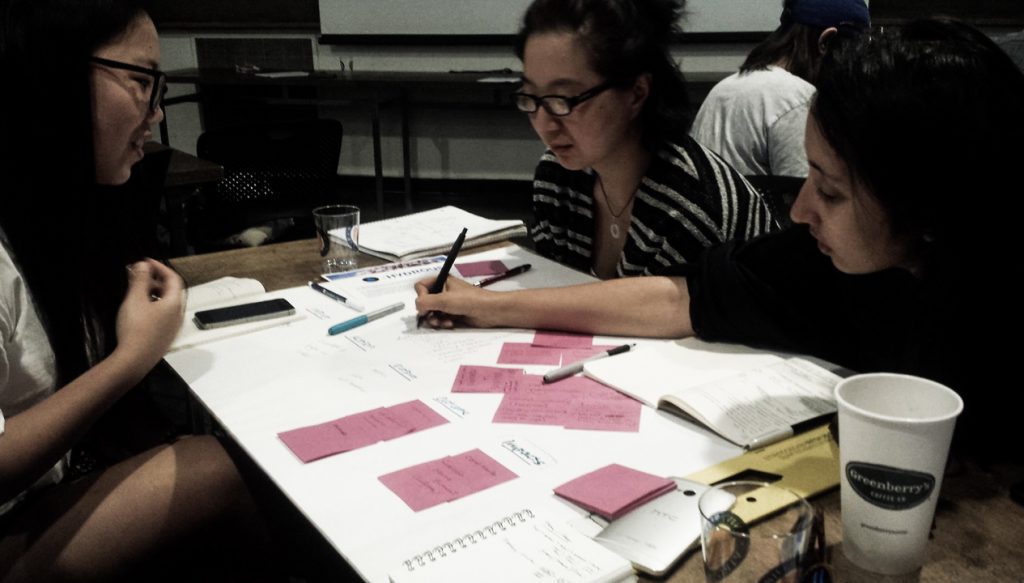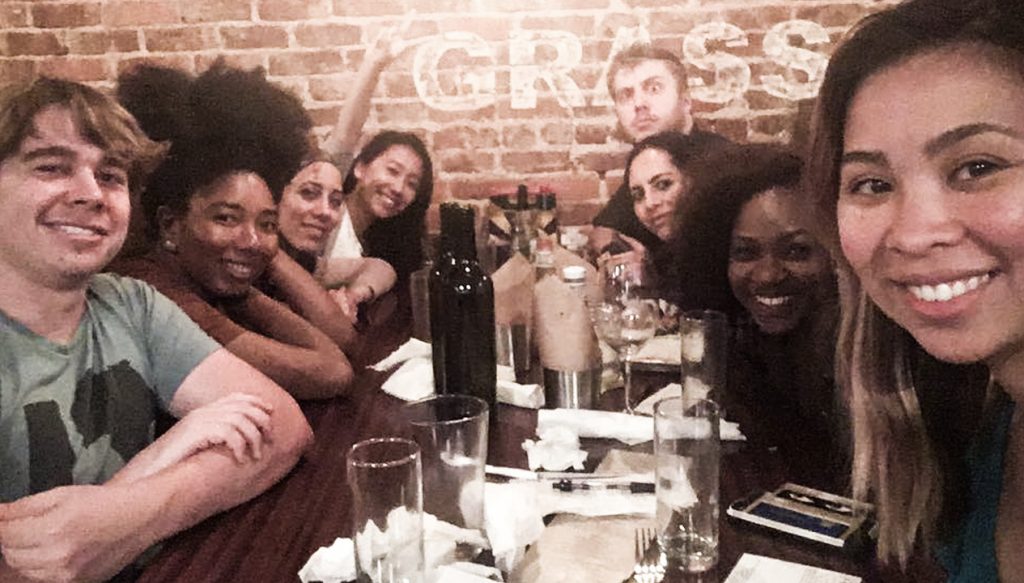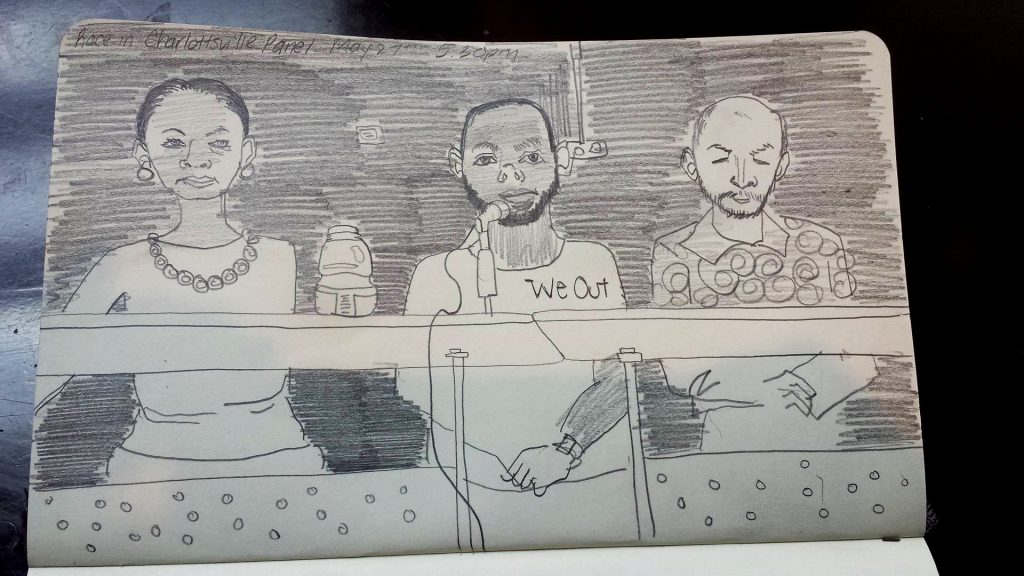Illustration student Grace Haynes recently traveled to Charlottesville, Virginia to attend the 2016 Design Futures Student Forum. In the story below, Grace shares her experiences over the 3-day event that focused on student leadership in social impact and public interest design. This year’s Forum, “Structures of Inclusion,” offered student leaders engaging sessions led by innovative thought-leaders in the social impact field, on utilizing human-centered design to foster creative community engagement and as a tool for racial equality and social justice.
Day 1
As I got off the plane headed to Design Futures Student Forum 2016, I was unsure about what to expect. Full of excitement and a bit of nervousness, I headed toward the University of Virginia with confidence and excitement to learn. Arriving two days in, I was a bit worried that everyone has already found their group of friends, and that I would be a little behind in terms of what we were all learning. However, as soon as I arrived at my dorm I was greeted by a group of very friendly peers who were more than willing to share what they learned the first two days.
The Design Futures Student Forum is a public interest design and student leadership forum focused around social impact and human-centered design. The themes of this year’s Forum were equity, empathy, and awareness. Social impact design attracts a variety of different disciplines from architecture, environmental design and illustration. I was one of the three illustrators at the convention, which forced me to learn so much about the world outside of illustration, and pushed my boundaries to help me become a more well-rounded designer.
The Forum was organized in workshops. We had the option to pick between two workshops with different speakers and topics. The first workshop I attended was called “Storytelling Methods for Community Engagement.” Thor Erickson, Director of BCworskhop, and his colleague Isaac Cohen taught my first workshop. BCworskhop is a Texas based non-profit organization that seeks to help improve the lives of others through social impact design. The speakers provided key points on how to go into communities and make an impact, and also tell their story in a thoughtful and empathetic way. This workshop really resonated with me due to the emphasis on making sure your heart is in the right place before you try to design solutions, as well as actually listening to the community members you are trying to help.

The workshops were a great way to meet new people and share our unique perspectives with one another.
After the workshop, we participated in a group activity in which we had to find a problem, and come up with a creative way to tell that story. This was great, because it got us thinking and collaborating with the rest of the attendees.
The Forum was non-stop all day. Even during our lunch break we were engaged in lectures and discussions. During the international panel, Michael Zaretky, a public interest designer and architect, discussed traveling abroad to design with communities. He broke down the changing the world cliché’s that we hear all the time, and helped us get to the root about why we want to travel and help these communities.
Right after lunch I headed to the next workshop with speaker Zoe Bezpalko from the Autodesk Foundation – her session was entitled “The Why and How of Measuring Impact.” The majority of the workshop was a group activity with the goal of creating a model that would ultimately measure the impact our cause would have. I enjoyed our group activities, because I got to meet new people as well as hear everyone’s varying perspectives and worldviews.
The Forum organized small groups of student attendees to reflect with at the end of the day. My group was amazing, empathetic and very engaged. It was nice to end the day with a recap, and share our experiences and stand-out moments that we had throughout the day.
Day 2
After my first day, I started to get the hang of how the Forum worked, and what I had to do to make the most of my experience. This day was dedicated to sensitive topics such as race and identity and how it affected Charlottesville, Virginia. The day began with a panel on the history of Charlottesville. We learned about how the past affects the present, and how history makes us who we are today.
After the panel I went to a workshop titled “ The Equity Transect” led by Marc Norman, from Harvard Graduate School of Design, and Liz Ogbu, a designer and social innovator. This workshop was awesome because it involved us taking the trolley out into the city, and exploring equity hands on. We went past the railroad track in Downtown Charlottesville to the affordable housing area. We were hosted by Claudette, the Director of Friendship Court, an organization that seeks to provide community-based art workshops and activities and connect locals across Charlottesville. Friendship Court supports and serves a community that has been forgotten. The place had fun decorations, and art was plastered all over the building creating a welcoming, and playful environment.
We also explored the building across the center that was being renovated to an upscale new business center for the communities. This raised questions on urban development, and creating a space that would make the affordable housing community feel welcomed.
We took the trolley back to campus to have a picnic lunch of the lawn. The Dean of the University gave an extensive tour on the history behind the architecture of the campus and the racial tensions at the University. I learned so much about this history of racism and slavery at the University of Virginia, and how the past affected the campus today. It was great to see the Dean acknowledge the past, and create a comfortable environment when it comes to dealing with America’s tragic history.

We dedicated a wall to our photos for the Design Futures 16′ yearbook. Super cool to see everyone’s faces!
One of the most groundbreaking activities we did that day as when we had to define discrimination with our peers. The activity was to find someone who looked similar in either race or gender and come together to define discrimination. After we had to find someone who looked ‘different’ from us and define discrimination again. I observed how much more challenging it was to define discrimination with someone ‘different’ and how that affected our outlook on life.
Day 3
Day 3 was amazing, sad, and thoughtful all in one. Knowing it was the last day some of us would see each other in a while, we started off the day socializing with all the wonderful people we met, and getting to know the faculty and speakers and their personal journeys.
We headed over to the auditorium to have a reflection about the week and discuss any thoughts and concerns we had about the conference. We got to hear one of the students beat box, and another student who was a great writer say a thoughtful poem about his experience. Then, we all gathered against the wall to form a circle, and had to say what the future was based off what we learned in the conference. I stated that the future was empathetic and understanding, because empathy and being able to listen to others issues is the only way we can understand each other’s experiences. Other said the future learns from the past, is beautiful, and is in our hands. Ultimately, the future is up to us and we felt a sense of responsibility after attending the conference to bring what we learned back home with us.

My new friends and I enjoy burgers after the Forum.
After the reflection was over I stayed for about 2 hours to keep talking and networking with my peers. We all hugged goodbye took plenty pictures and promised to keep in touch. There was this feeling that we would see each other again considering how small the field is.
My flight didn’t leave until the next day so I had some time to explore more of Virginia. A couple of friends and I went to Thomas Jefferson’s Monticello and learned about the history of slavery and our past president in Virginia. It was interesting to see how important history was to Virginia, and how a small town had such a major impact on our country.
On the plane ride home I got a chance to sit back and reflect on all the wonderful experiences I had had. It was crazy how much I learned, and gotten close to so many people considering the small amount of time I was there. The conference was definitely a week to remember.
——————————————————————————————————————————-
Grace Haynes is a Los Angeles based Painter / Illustrator / Designer currently attending the ArtCenter College of Design. To learn more about Grace and her work click here.
This opportunity was made possible in part by support from the Designmatters Educational Program Grant from the Autodesk Foundation.

